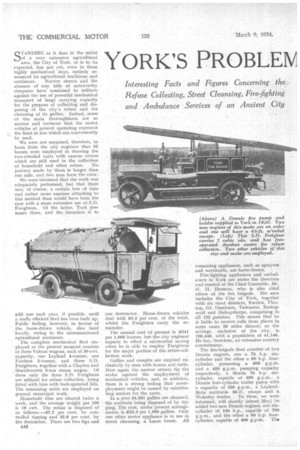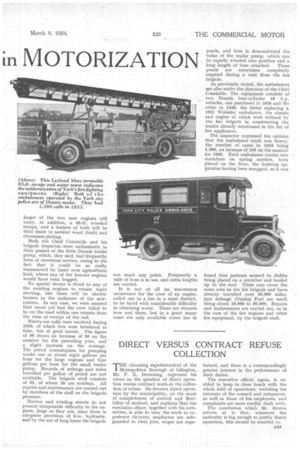YORK'S PROBLE1V
Page 108

Page 109

If you've noticed an error in this article please click here to report it so we can fix it.
in MOTORIZATION
Interesting Facts and Figures Concerning the Refuse Collecting, Street Cleansing, Fire-fighting and Ambulance Services of an Ancient City
C TANDING as it does in the midst
of a very extensive agricultural area, the City of York, as is to be expected, has not yet, even in these highly mechanized days, entirely renounced its agricultural traditions and sentiment. Narrow streets and the absence of any hills of noteworthy steepness have combined to militate against the use of powerful mechanical transport of large carrying capacity for the purpose of collecting and disposing of the city's refuse and the cleansing of its gullies. Indeed, some of the main thoroughfares are so narrow and tortuous that the motor vehicles at present operating represent the limit in size which can conveniently he used.
We were not surprised, therefore, to learn from the city engineer that 32 horses were employed in drawing the two-wheeled carts with canvas covers which are still used in the collection of household and other refuse. No journey made by them is longer than one mile, and two men form the crew.
We were informed that the work was adequately performed, but that there was, of course, a certain loss of time and rather more expense attaching to this method than would have been the case with a more extensive use of S.D. Freighters. Of the latter, York possesses three, and the intention is to add one each year, if possible, until a really efficient fleet has been built up. Public feeling, however, in favour of the horse-drawn vehicle, dies hard locally, owing to the aforementioned agricultural sentiment.
The complete mechanical fleet employed at the present moment consists of three Vulcan wagons, each of 30-cwt, capacity, one Leyland 4-tonner, one Fordson 2-tonner, and three S.D. Freighters, together with a Clayton and Shuttleworth 5-ton steam wagon. Of these only the three S.D. Freighters are utilized for refuse collection, being fitted with bins with foot-operated lids. The remaining units are employed on general municipal work.
Household bins are cleared twice a week, and the average weight per 100 is 18 cwt. The refuse is disposed of as follows : —67.2 per cent. by controlled tipping and 32.8 per cent, by the destructor. There arc two tips and E42 one destructor. Horse-drawn vehicles deal with 83.3 per cent, of the total, whilst the Freighters carry the remainder.
The annual cost at present is £541 per 1,000 houses, but the city engineer expects to effect a substantial saving when he is able to employ Freighters for the major portion of the refuse-collection work.
Gullies and cesspits are emptied exclusively by men with horses and carts. Here again the narrow streets tip the scales against the employment of mechanical vehicles, and, in addition, there is a strong feeling that unemployment might be caused by substituting motors for the carts.
In a year 54,261 gullies are cleansed, the contents being disposed of by tipping. The cost, under present arrangements, is £23.3 per 1,000 gullies. Only one other motor appliance is in use in street cleansing, a Lacre brush. All temaining appliances, such as sprayers and watercarts, are horse-drawn.
Fire-fighting appliances and ambulances in York are under the direction and control of the Chief Constable, Mr. H. II. Herman, who is also chief officer of the fire brigade. His area includes the City of York, together with six rural districts, Eserick, Flaxton, Gt. Ouseburn, Tadcaster, Easingwold and Bishopthorpe, comprising in all 122 parishes. This means that he is liable to receive calls from places in some cases 20 miles distant, as the acreage, exclusive of the city, is 196,446, with a population of 41,146. He has, therefore, an extensive country commitment.
The fire-brigade fleet consists of two Dennis engines, one a 75 h.p. sixcylinder and the other a 60 h.p. fourcylinder, possessing a 600 g.p.m. and a 450 g.p.m. pumping capacity respectively, a Morris 75 h.p. sixcylinder, capable of 600 g.p.m., a Dennis four-cylinder trailer pump with a capacity of 250 g.p.m., a LeylandMetz turntable 85-ft. escape and a Wolseley tender. To these, we were informed, will shortly (about May) be added two new Dennis engines, one sixcylinder of 100 h.p., capable of 700 g.p.m., and the other a 60 h.p. fourcylinder, capable of 400 g.p.m. The
larger of the two new engines Will carry, in addition, a 65-ft. wheeled escape, and a feature of both will be their finish in natural wood (teak) and chromium-plating.
Both the Chief Constable and his brigade inspector were enthusiastic in their praises of the little Dennis trailer pump, which, they said, had frequently been of enormous service, owing to the fact that it could be so easily manceuvred by hand over agricultural land, where any of the heavier engines would have been bogged.
No special device is fitted to any of the existing engines to ensure rapid starting, but there will be electric heaters in the radiators of the newcomers. In any case, we were assured that never yet had the crew failed to be on the road within one minute from the time of receipt of the call.
Ninety-six calls were received during 1933, of which five were tabulated as false, but of good intent. The figure of 96 shows an increase of 20 on the number for the preceding year, and a slight increase on the average. The petrol consumption for pumping works out at about eight gallons per hour for the large engines and four gallons per hour for the small trailer pump. Records of mileage and miles travelled per gallon of petrol are not available. The brigade staff consists of 34, of whom 18 are resident. All repairs and maintenance are carried out by members of the staff on the brigade premises.
Narrow and winding streets do not present insuperable difficulty to the engines, large as they are, since there is adequate provision of 4-in, hydrants, and by the use of long hoses the brigade can reach any point, Frequently a mile of hose is in use, and extra lengths are carried.
It is not at all an uncommon occurrence for the crew of an engine, called out to a fire in a rural district, to be faced with considerable difficulty in obtaining water. There are streams here and there, but in a great many cases the only available water lies in ponds, and here is demonstrated the value of the trailer pump, which can be rapidly wheeled into position and a long length of hose attached. These ponds are sometimes completely emptied during a visit from the fire brigade.
As previously stated, the ambulances are also under the direction of the Chief Constable. The equipment consists of two Dennis four-cylinder 18 h.p. vehicles, one purchased in 1926 and the other in 1930, the latter replacing a 1921 Wolseley ambulance, the chassis and engine of which were utilized by the fire brigade in constructing the tender already mentioned in the list of fire appliances.
The inspector expressed the opinion that the ambulance work was heavy, the number of cases in 1933 being 1,390, an increase of 163 on the number for 1932. Each ambulance carries two stretchers on spring carriers, both placed on the floor, the hoisting apparatus having been scrapped, as it was found that patients seemed to dislike being placed on a stretcher and hauled up to the roof. These cars cover the same area as the fire brigade and have already travelled over. 40,000 miles, tyre mileage (Dunlop Fort are used) being about 18,000 to 20,000.. Repairs and maintenance are carried out, as in the case of the fire engines and other tire equipment, by the brigade staff.












































































































































































